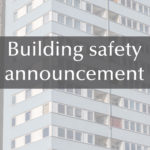Housing Secretary Robert Jenrick MP has announced ambitious steps to further reform the building safety system with the biggest changes in a generation to ensure residents are safe in their homes.
New measures announced today include mandatory sprinkler systems and consistent wayfinding signage in all new high-rise blocks of flats over 11 metres tall.
The independent construction expert David Hancock has also been appointed to review the progress of unsafe ACM claddings from buildings.
The reforms are designed to incentivise compliance and to better enable the use of enforcement powers and sanctions, including prosecution where the rules are not followed.
The Housing Secretary will hold a roundtable with mortgage lenders to work on an agreed approach to mortgage valuations for properties in buildings under 18 metres tall, providing certainty for owners affected by vital building safety work.
Housing Secretary Rt Hon Robert Jenrick MP said: “The Government is bringing about the biggest change in building safety for a generation.
“Today we have made a major step towards this by publishing our response to the Building a Safer Future consultation. This new regime will put residents’ safety at its heart, and follows the announcement of the unprecedented £1bn fund for removing unsafe cladding from high-rise buildings in the Budget.
“Today we are also announcing that the housing industry is designing a website so lenders and leaseholders can access the information needed to proceed with sales and re-mortgaging, and the Government stands ready to help to ensure this work is completed at pace.
“Building safety is a priority and the Government is supporting industry in ensuring homes are safe at this difficult time.”
The measures build on recent announcements including:
- Providing £1bn in 2020/21 to support the remediation of unsafe non-ACM cladding materials on high-rise buildings. This is in addition to the £600m already available remediation of high-rise buildings with unsafe ACM cladding
- Naming building owners who have been slow to act in removing unsafe ACM cladding
- The introduction of the Fire Safety Bill, which took us one step further in delivering the recommendations of the Grenfell Inquiry’s Phase One report
The latest non-ACM (aluminium composite material) cladding testing results have been published today and show that none of the materials, including high-pressure laminate (HPL) and timber cladding, behaved in the same way as ACM.
The Government is clear that any unsafe materials should be removed from buildings quickly. External wall systems on high-rise buildings using Class C or D HPL panels are unsafe and should be removed as they do not comply with Building Regulations.
The Government recognises the challenges presented to the building industry by COVID-19. The work to remove unsafe cladding from buildings is critical to public safety and so remains a top priority.
Government is supporting building owners, managers and residents to ensure remediation work continues where it is safe to do so. The Government has also made clear that vital maintenance and repair work can continue to take place in line with public health guidance.
LGA response
Lord Porter, the Local Government Association’s Building Safety Spokesman, said: “Residents have a right to be safe and feel safe in their own homes. This is even more important during the current coronavirus pandemic, as so many people are confined to their homes.
“The Government’s announcement that the remediation of cladding remains a top priority is positive news, and industry and duty-holders now need to step up and deliver the work required. Leaseholders, who are facing a triple whammy of mortgage refusals, spiralling insurance costs and fees for emergency safety measures, cannot continue to be subjected to months of further delays, as long as it is possible for cladding replacement work to proceed in line with safety advice.
“The LGA has long called for the requirement for sprinklers in new blocks to be lowered, and the decision to reduce that for new blocks from 30 metres tall to 11 metres tall is incredibly important to the health and safety of residents. Residents of existing blocks deserve the same safety standards as those in new buildings, and the Government should fund the retrofitting of sprinklers in existing blocks of flats, once the current crisis is over.
“We also remain concerned that the scope of the new building safety regime overlooks buildings we believe have been built just below a height of 18 metres specifically to game the system and dodge safety standards.
“We will continue to work with the Government at pace to make the case for further reform to ensure residents are safe.”









